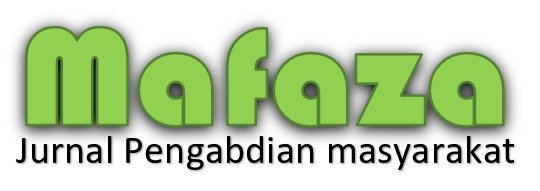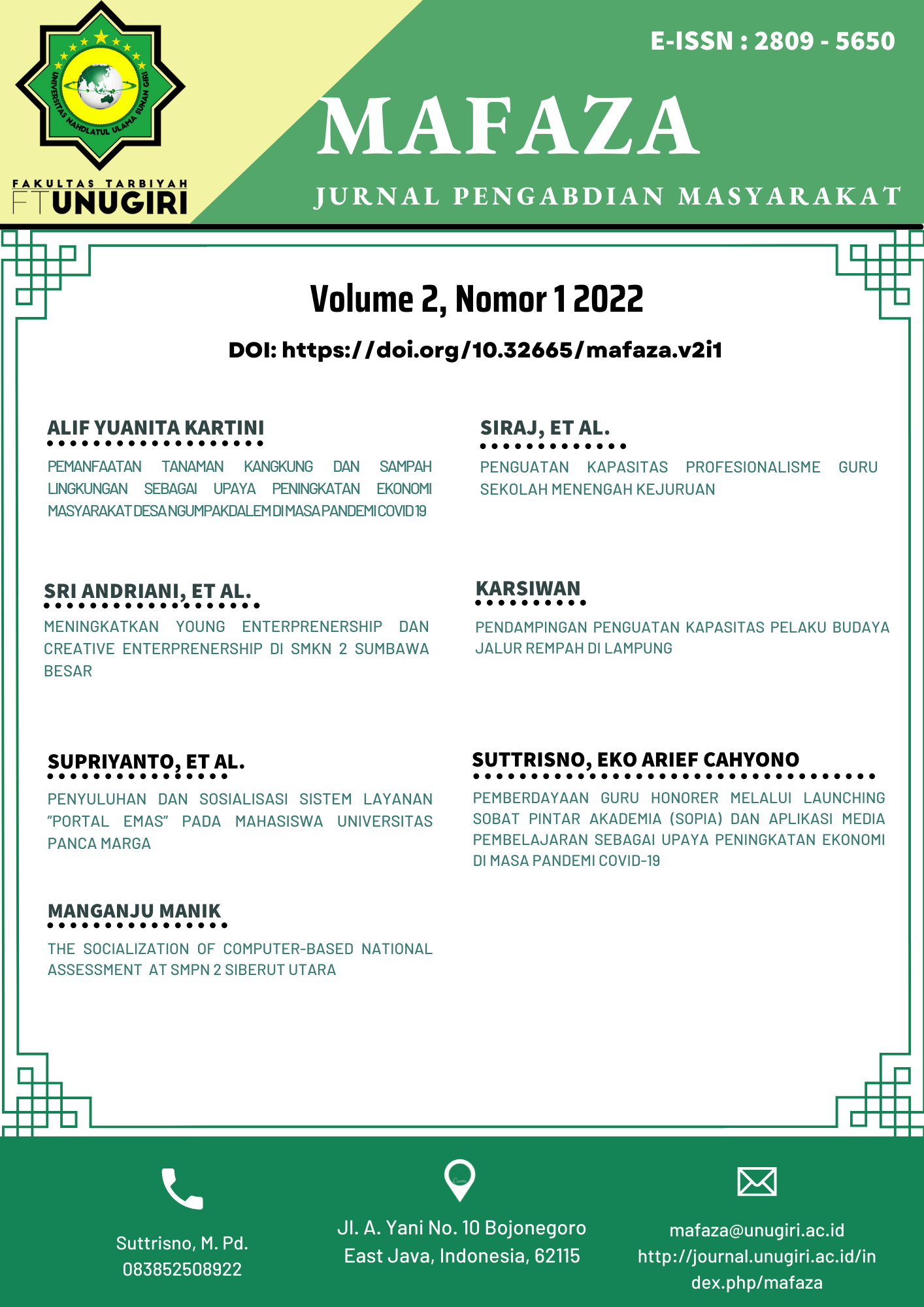PEMANFAATAN TANAMAN KANGKUNG DAN SAMPAH LINGKUNGAN SEBAGAI UPAYA PENINGKATAN EKONOMI MASYARAKAT DESA NGUMPAKDALEM DI MASA PANDEMI COVID 19
 PDF Download: 1954
PDF Download: 1954
DOI:
https://doi.org/10.32665/mafaza.v2i1.437Keywords:
kangkung, sampah lingkungan, peningkatan ekonomi masyarakat,, pandemi covid 19Abstract
Water spinach is commonly found around the community of Ngumpakdalem Village. Most people do not know the benefits and uses of kale. In addition, in Ngumpakdalem Village, a lot of plastic waste such as used drinking water bottles and even steroform were found. Of course this will interfere with environmental health if the people of Ngumpakdalem Village have not been able to manage waste properly. Therefore, in community service activities in Ngumpakdalem Village in collaboration with partners, in this case IDFoS Indonesia, Dalem Mandiri Sejahtera Group, Mandiri Sehat Group 1 and Mandiri healthy Group 2, held training on environmental waste management both organic and inorganic as organic fertilizer and media. environmentally friendly planting for kale plants. In this community service activity, the Asset Based Community Development (ABCD) method is used, which is a community development concept based on local assets to overcome problems in the area. The results of this community service activity are in the form of "snack ndalem" food products in the form of finger cakes, chips and crackers with various flavors including original, balado, spicy, and barbeque and traditional herbal medicine "viks drink" with the basic ingredients of kale. organic. These food and beverage products are very helpful for the community in terms of empowering the family economy and fostering UKM and UMKM so that they can improve the economy of the Ngumpakdalem village community during the Covid 19 Pandemic.
References
Badan Pusat Statistik. 2020. “Kecamatan Dander dalam Angka” Kabupaten Bojonegoro Dalam Angka 1–68.
Larasati, Nisa, and Laila Fitria. 2020. “Analisis Sistem Pengelolaan Sampah Organik Di Universitas Indonesia (Studi Kasus Efektivitas Unit Pengolahan Sampah UI Depok).” Jurnal Nasional Kesehatan Lingkungan Global 1(2).
Marliani, Novi. 2015. “Pemanfaatan Limbah Rumah Tangga (Sampah Anorganik) Sebagai Bentuk Implementasi Dari Pendidikan Lingkungan Hidup.” Formatif: Jurnal Ilmiah Pendidikan MIPA 4(2).
Nugraha, Aldila Wanda. 2019. “Pemberdayaan Masyarakat Desa Sumberdadi Dengan Pelatihan Hidroponik Dan Pupuk Organik.” JPP IPTEK (Jurnal Pengabdian Dan Penerapan IPTEK) 3(1):25–32.
Robbani, Shofa. 2021. “Budi Daya Tanaman Hidroponik Asman Toga Sebagai Inovasi Media Tanam Ramah Lingkungan.” AL-UMRON: JURNAL PENGABDIAN KEPADA MASYARAKAT 2(1):43–54.
Rofi’ah, Firda Zakiyatur, and Wahyu Setia Kuscahyaning Putri. 2021. “Pengolahan Limbah Menjadi Makanan Ringan Di Desa Tikusan Kecamatan Kapas Kabupaten Bojonegoro.” Mafaza: Jurnal Pengabdian Masyarakat 1(1):52–57.
Suryaningsih, Suryaningsih, Irwan Said, and Nurdin Rahman. 2018. “Analisis Kadar Kalsium (Ca) Dan Besi (Fe) Dalam Kangkung Air (Ipomeae Aquatica Forsk) Dan Kangkung Darat (Ipomeae Reptan Forsk) Asal Palu.” Jurnal Akademika Kimia 7(3):130–35.
Suttrisno, S., Riyanto, Y., & Subroto, W. T. (2020). Pengaruh Model Value Clarification Technique (Vct) Berbasis Kearifan Lokal Terhadap Motivasi Belajar Dan Hasil Belajar Siswa. NATURALISTIC: Jurnal Kajian Penelitian Pendidikan dan Pembelajaran, 5(1), 718-729.
Wulandari, Nadia, F. Lawrenche, N. Ramadhan, F. Rahayu, M. A. Bakhtiar, and A. Nurrachmawati. 2021. “Pemberdayaan Masyarakat Di Masa Pandemi Covid-19 Pada Ikatan Remaja Masjid Rt. 04 Loa Kulu.” Kumawula J Pengabdi Kpd Masy 3(3):429.
Yustiani, Yonik Meilawati, Anni Rochaeni, and Elva Aulia. 2019. “Konsep Pengelolaan Sampah Di Desa Babakan Kabupaten Bandung.” EnviroScienteae 15(1):121–26.
Downloads
Published
How to Cite
Issue
Section
License
Copyright (c) 2022 Mafaza : Jurnal Pengabdian Masyarakat

This work is licensed under a Creative Commons Attribution 4.0 International License.
 PDF Download: 1954
PDF Download: 1954







